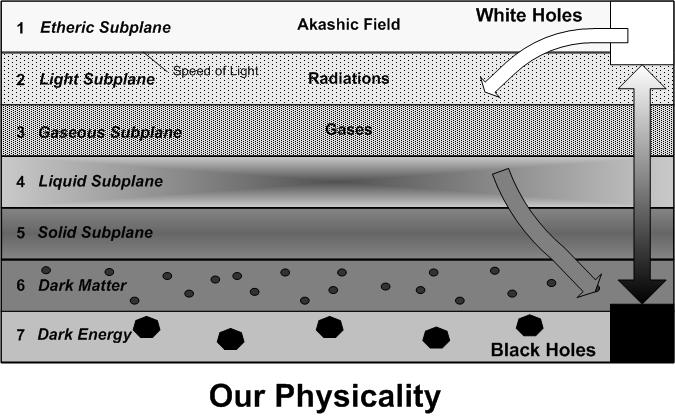Dark matter
 Until recent scientific discoveries, most every field of study considered our solid subplane as the densest form of matter in our universe. The only subtle hint that something else exists comes from metaphysics in which The Tibetan postulated that the lowest three subplanes of our physicality are not “principles” in this expression of our universe. Without getting into the details of theoretical physics, observations of spiral-shaped galaxies like our Milky Way do not fit scientific theory. Simply, the outermost stars and matter in the galaxy should be moving at a greater velocity than the stars near the core where most of the visible physical matter is located.
Until recent scientific discoveries, most every field of study considered our solid subplane as the densest form of matter in our universe. The only subtle hint that something else exists comes from metaphysics in which The Tibetan postulated that the lowest three subplanes of our physicality are not “principles” in this expression of our universe. Without getting into the details of theoretical physics, observations of spiral-shaped galaxies like our Milky Way do not fit scientific theory. Simply, the outermost stars and matter in the galaxy should be moving at a greater velocity than the stars near the core where most of the visible physical matter is located.
 Recent observations can only be consistent with the laws of physics if there's as much mass in our galaxy at the periphery as at the core. But what and where is this missing mass? Labeled dark matter, it needs to include at least 10 times the mass associated with all visible matter in our galaxy out to distances at least 10 times as far as visible matter. The reason it is called dark matter is that it is very different from ordinary matter. The difference is that dark matter does not emit radiation as normal matter does when excited. This dark matter seems to surround spiral galaxies as a "dark halo."
Recent observations can only be consistent with the laws of physics if there's as much mass in our galaxy at the periphery as at the core. But what and where is this missing mass? Labeled dark matter, it needs to include at least 10 times the mass associated with all visible matter in our galaxy out to distances at least 10 times as far as visible matter. The reason it is called dark matter is that it is very different from ordinary matter. The difference is that dark matter does not emit radiation as normal matter does when excited. This dark matter seems to surround spiral galaxies as a "dark halo."
 Visually, I get that dark matter dominates the periphery of galaxies, while ordinary matter dominates toward the center. Another property of dark matter is that it interacts weakly with ordinary matter. Other than being affected by gravity, dark matter is not affected by known physical forces. A number of theories have been put forth as to what dark matter is, but since we cannot observe or detect dark matter directly, what composes dark matter still remains a mystery.
Visually, I get that dark matter dominates the periphery of galaxies, while ordinary matter dominates toward the center. Another property of dark matter is that it interacts weakly with ordinary matter. Other than being affected by gravity, dark matter is not affected by known physical forces. A number of theories have been put forth as to what dark matter is, but since we cannot observe or detect dark matter directly, what composes dark matter still remains a mystery.
Take a Journey through our
Spirit/Matter Universe
Our Somewhat Unusual Physicality
by Jef Bartow
 Today we begin a new article series. Two sections of my first book God, Man and the Dancing Universe are devoted to describing in detail our spirit/matter objective/subjective universe. This article series is intended to provide a concise simple experiential explanation of the diversity and unity of the various Planes and Realms that make up our systemic universe. So, as I suggest in the foreword of my book, make it a: journey first and intellectual understanding second.
Today we begin a new article series. Two sections of my first book God, Man and the Dancing Universe are devoted to describing in detail our spirit/matter objective/subjective universe. This article series is intended to provide a concise simple experiential explanation of the diversity and unity of the various Planes and Realms that make up our systemic universe. So, as I suggest in the foreword of my book, make it a: journey first and intellectual understanding second.
The perennial philosophy drawn from metaphysics, eastern and western mysticism, psychology, philosophy and science concludes that our universe is made up of various levels of energy which can be labeled planes, worlds, realms, consciousness, etc. The number seven is usually associated with these various levels. In this and future articles, we will similarly come to the same number of seven as the number of subplanes within each major level of energy we can experience in outer Objectivity. Later, we will journey into the inner part of Objectivity and finally, Subjectivity itself, each with its own structure.
 It would seem the easiest place to start would be our physicality. Unfortunately, our physicality is just as diverse and almost incomprehensible as many of the high spiritual Planes or subjective Realms are. So let's start with the easiest part, that part of our universe which we can experience with our five physical senses.
It would seem the easiest place to start would be our physicality. Unfortunately, our physicality is just as diverse and almost incomprehensible as many of the high spiritual Planes or subjective Realms are. So let's start with the easiest part, that part of our universe which we can experience with our five physical senses.
Our articles are available for reproduction for all members. Please give credit to the author.
For non-members, contact us for permission to reproduce articles.
Our somewhat visible universe
 As we take a walk in nature it is relatively easy to experience the solidity of physical matter. Our dense physical subplane is composed of rocks, minerals, mountains, trees and much of we what we experience in nature. The crust of our earth contains much of our solid physical plane.
As we take a walk in nature it is relatively easy to experience the solidity of physical matter. Our dense physical subplane is composed of rocks, minerals, mountains, trees and much of we what we experience in nature. The crust of our earth contains much of our solid physical plane.
 The inner layers of our earth as well as much on and above the surface of our earth are actually not solid, but liquid or gaseous. We easily experience our liquid subplane in the water in our rivers, oceans and clouds; the blood running through our veins and arteries and the liquids we drink. Our next less dense physical subplane are our gases that we experience in the steam rising from our geysers and boiling water; the air we breathe, the anesthesia we sometimes take before surgery and the various gases we learn about in chemistry.
The inner layers of our earth as well as much on and above the surface of our earth are actually not solid, but liquid or gaseous. We easily experience our liquid subplane in the water in our rivers, oceans and clouds; the blood running through our veins and arteries and the liquids we drink. Our next less dense physical subplane are our gases that we experience in the steam rising from our geysers and boiling water; the air we breathe, the anesthesia we sometimes take before surgery and the various gases we learn about in chemistry.
 These three subplanes are differentiated by how much heat or energy is absorbed in them. If we heat frozen water (ice) it becomes liquid water. If we heat liquid water it finally turns into a gas. If we heat or pressurize a gas, there comes a point at which it will emit forms of energy call radiation. Radiation is simply defined as "rays of light; radiant energy." So, our various forms of light form another subplane of our physicality, one that is less dense or more energetic than the ones we've just described.
These three subplanes are differentiated by how much heat or energy is absorbed in them. If we heat frozen water (ice) it becomes liquid water. If we heat liquid water it finally turns into a gas. If we heat or pressurize a gas, there comes a point at which it will emit forms of energy call radiation. Radiation is simply defined as "rays of light; radiant energy." So, our various forms of light form another subplane of our physicality, one that is less dense or more energetic than the ones we've just described.
Dark energy
 If that wasn't enough to put a monkey wrench into our understanding of physical matter, in 1998 astronomers discovered that "something is pulling the universe apart." This something is "causing galaxies to flee from each other at an ever-faster rate." This is directly contrary to science's understanding that "the mutual gravity of all the matter in the cosmos is thought to be slowing down the expansion that began with the big-bang."
If that wasn't enough to put a monkey wrench into our understanding of physical matter, in 1998 astronomers discovered that "something is pulling the universe apart." This something is "causing galaxies to flee from each other at an ever-faster rate." This is directly contrary to science's understanding that "the mutual gravity of all the matter in the cosmos is thought to be slowing down the expansion that began with the big-bang."
 For lack of a better term, they label this matter as "dark energy." It is thought to be distributed uniformly throughout space and its strength will remain constant throughout time. Science now concludes that this matter makes up about 70% of the mass of our physical universe. Consistent with dark matter, these particles of dark energy do not interact with ordinary matter. Therefore our normal perception does not perceive this subplane.
For lack of a better term, they label this matter as "dark energy." It is thought to be distributed uniformly throughout space and its strength will remain constant throughout time. Science now concludes that this matter makes up about 70% of the mass of our physical universe. Consistent with dark matter, these particles of dark energy do not interact with ordinary matter. Therefore our normal perception does not perceive this subplane.
 The various forms of radiation in our universe carry intense energy. Even though we cannot see most of these energies/particles, they are real. Some that we do see include fire, sunlight and infrared radiation. Some that we do not see but have come to except as real are radio waves, x-rays and gamma rays.
The various forms of radiation in our universe carry intense energy. Even though we cannot see most of these energies/particles, they are real. Some that we do see include fire, sunlight and infrared radiation. Some that we do not see but have come to except as real are radio waves, x-rays and gamma rays.
.
The ether
Science defines the absolute maximum velocity within our universe as the speed of light. Science for a period of time and currently metaphysics and many other fields of study also define a level of energy beyond the speed of light as the ether. Various terms for this ether have included pneuma or subtle matter in philosophy and the sea of fire or soul of Matter in metaphysics. This highest subplane of our physicality is generally considered to hold the records (Akashic records) of all physical life experience.
Conclusion
 The highest most refined or spiritualized level of our physicality is our physical ether, a sea of fire or pneuma which contains the energetic records of our past and present physical experiences. The next four denser levels of our physical energies comprise the radiations of our light subplane and our commonly experienced gaseous, liquid and solid subplanes. Two denser subplanes that we do not perceive directly, but comprise more than 90% of the mass of our physical universe, are dark matter and dark energy.
The highest most refined or spiritualized level of our physicality is our physical ether, a sea of fire or pneuma which contains the energetic records of our past and present physical experiences. The next four denser levels of our physical energies comprise the radiations of our light subplane and our commonly experienced gaseous, liquid and solid subplanes. Two denser subplanes that we do not perceive directly, but comprise more than 90% of the mass of our physical universe, are dark matter and dark energy.
 As we will see in future articles, each of our seven outer objective Planes (major energy levels) are similarly broken down into seven sublevels. Together these 7 major Planes form the seven subplanes of our Cosmic Physical Plane which is the densest playground within the cosmic universe. Therefore, our 7 Planes universe can be viewed as the lowest of seven levels within the makeup of the "the Being in whom we live, move and have our being," just as physicality is one of seven levels within our systemic existence.
As we will see in future articles, each of our seven outer objective Planes (major energy levels) are similarly broken down into seven sublevels. Together these 7 major Planes form the seven subplanes of our Cosmic Physical Plane which is the densest playground within the cosmic universe. Therefore, our 7 Planes universe can be viewed as the lowest of seven levels within the makeup of the "the Being in whom we live, move and have our being," just as physicality is one of seven levels within our systemic existence.






